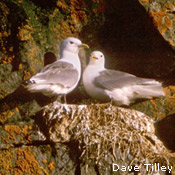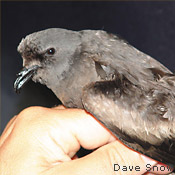
- How to get There
- Activities
- Maps
- Services
- Fees and Schedules
- Rules and Regulations
- Permits
- Other Resources
- Contact Information
- Approved Guides
Baccalieu Island is the largest protected seabird island in Newfoundland and Labrador. During the summer, it has more types of breeding seabirds than any other seabird colony in the province, and its 3,360,000-plus pairs of Leach’s storm petrels make it the largest Leach’s storm petrel colony in the world.
Located just off the northwestern tip of the Avalon Peninsula, near Bay de Verde, the reserve takes in the 5 km2 of the island itself and an extra kilometre of ocean around its coast, bringing the reserve size to 23 km2.
During the breeding season (April 1 to October 30), access to the seabird nesting areas is restricted to scientific researchers and people with valid access permits. Other parts of the island may be visited at any time without a permit. Note that boat landings at Ned Walsh’s Cove and London Cove can be dangerous and should only be attempted by experienced boaters. The island is visible from shore, across Baccalieu Tickle, and from Red Head Cove. At the Bay de Verde Heritage House Museum, interpretive exhibits explain the natural and cultural history of Baccalieu Island and the region.
This island may host more breeding Leach’s storm petrels than anywhere else in the world, but it is very hard to catch sight of these birds. During the day and when they are feeding, storm petrels are at sea. Only at night do Baccalieu’s grassy slopes and inland forest teem with life, when millions of flying and singing petrels return to their underground nesting burrows using the protective cover of darkness.

In addition to the millions of petrels, the Baccalieu Island Ecological Reserve is the second-largest puffin colony (after the Witless Bay Ecological Reserve) in North America. More than 75,000 pairs nest on Baccalieu’s grassy slopes and surrounding rock scree. Black-legged kittiwakes, common and thick-billed murres, razorbills, and Northern fulmars are also present.
Written records of Baccalieu Island date back to the earliest days of European exploration of North America. The region played an important role in the fishery for more than four centuries.
This important seabird breeding site is located in the Eastern Hyper-oceanic Barrens Ecoregion (862 KB). It was given provisional ecological reserve status in 1991, and became a designated Ecological Reserve in 1995.
How to get there
Bay de Verde is about 132 km from Whitbourne (on the Trans-Canada Highway) on Newfoundland’s Avalon Peninsula. It is about a two-hour drive on paved highway from St. John’s.
During breeding season, access to the sensitive nesting areas of the island is only permitted for scientific researchers, those with access permits, and management staff. The Island can be viewed from shore across the tickle. A path leaves from the community of Bay de Verde and goes to Split Cove, which is approximately a 30-minute walk.
Aircraft are prohibited from landing in the reserve, or flying lower than 300 metres from April 1 to October 30. No tankers or vessels longer than 20 metres are permitted in the marine portion of the reserve.
Activities
From April 1 to October 30, activities other than permitted scientific research are not allowed in the sensitive nesting areas on the island. However, low-impact visits are allowed in non-sensitive areas on the island at any time. For a map of the sensitive nesting areas contact Natural Areas Program.
The reserve can be viewed across the 6 km of Baccalieu Tickle. A path leaves from the community of Bay de Verde and goes to Split Cove, which is approximately a 30 minute walk. In the summer, in addition to the birds on the island, whales and icebergs can sometimes be seen from these vantage points.
Commercial and recreational fishing can occur in the waters of the reserve. All provincial and federal regulations apply when fishing in the reserve. Boaters must be careful in the marine portion of the reserve so as not to disturb the birds.
There are currently no licensed commercial tour boat operators registered with the Natural Areas Program that can take the public around the island.
Motorized boats are not permitted within 100 metres of the cliffs containing nesting birds during the breeding season, except at the designated (and somewhat difficult) landing sites at Ned Walsh’s Cove and London Cove. Non-motorized boats can approach to 20 metres. It is important that any boaters approaching the island behave responsibly, so as not to disturb the birds.
The Bay de Verde Heritage Premises’ has interpretive exhibits about Baccalieu Island and its birds.
The Canadian Coast Guard operates two automated navigational aids on Baccalieu Island.
Services
There are no services within the reserve so it is important to use these guidelines when preparing for your visit:
- Make sure you have a permit, if required
- Let someone know your route and expected time of return
- Travel light and leave no trace of your passage
- Carefully plan your clothing, footwear, and equipment
- Take a compass and appropriate 1:50,000 topographic maps
- Read and abide by the rules and regulations
Note that if you take a cell-phone, coverage will be spotty-though it is possible to make calls from some hilltops.
Fees and Schedule
There are no fees involved in obtaining scientific research, educational tour, or commercial operator permits. However scientific research permit applications must be submitted to the Natural Areas Program by March 31 for review by the Seabird Ecological Reserves Advisory Committee.
Baccalieu Island can be accessed year-round, though visiting the sensitive breeding areas is restricted to researchers from April 1 to October 30.
Rules and Regulations
Biodiversity protection and habitat conservation are two of the key purposes of ecological reserves, so certain rules apply within all the reserves in the province.
The public can visit most ecological reserves for educational purposes or low-impact recreational activities, such as hiking or sightseeing.
These activities are restricted in the sensitive nesting areas on Baccalieu Island, however, from April 1 to October 30. At that time only those conducting approved scientific research, people with valid access permits, and authorized government personnel can visit the seabird nesting areas.
Hiking is not allowed in the nesting areas during the breeding season.
The following activities are strictly prohibited in all wilderness and ecological reserves:
- Disturbing, destroying, or removing plants, animals, or fossils
- Introducing plants, animals, or anything else to the reserve landscape
- Forestry, mining (including exploration), hydro development, agriculture, new roads, tracks, or buildings
- Driving off-road vehicles including all-terrain vehicles (ATVs)
In addition, at Baccalieu Island Ecological Reserve:
- No hunting is allowed in the reserve.
- Motorized boats are not permitted within 100 metres of the cliffs with nesting birds during the breeding season (April 1 to October 30), except at the designated (and somewhat difficult) landing sites at Ned Walsh’s Cove and London Cove.
- Non-motorized boats can approach to 20 metres during the breeding season (April 1-Oct 30).
- Boaters approaching the island must do so carefully, so as not to disturb the birds.
- Tankers or other vessels longer than 20 metres are not permitted within the marine portion of the reserve.
- Restrictions also apply to cruise ships in the area – see Permits.
- Commercial and recreational fishing in accordance with other applicable legislation is permitted within the marine waters of the reserve.
- Aircraft are not permitted to fly lower than 300 metres, take off, or land within the reserve from April 1 to October 30.
Complete rules and regulations for scientific researchers, fishers, local residents, commercial tour boat operators, Coast Guard staff, and other potential visitors are available online.
Read the official reserve regulations:
- Seabird Ecological Reserve Regulations
- Baccalieu Island Ecological Reserve Order
- Wilderness and Ecological Reserves Act
Approved Guides
| (Bill) W. A. Montevecchi Tel: (709) 737-7673 Fax: (709) 737-4000 Email: mont@mun.ca |
| Mr. Pierre Ryan Tel: (709) 772-4431 Home: (709) 722-5794 Email: pierre.ryan@ec.gc.ca Email: lyra@nf.sympatico.ca |
Adobe® Acrobat® Reader software can be used for viewing PDF documents. Download Acrobat® Reader for free

